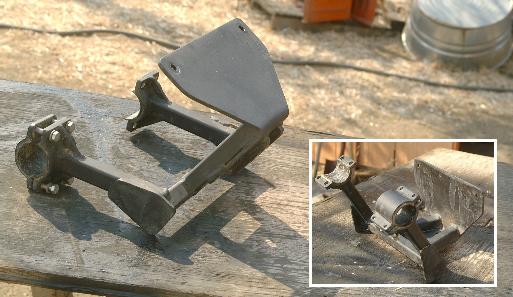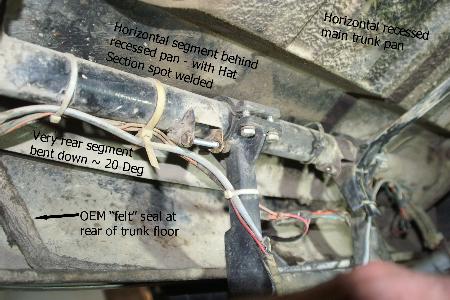The MGA With An Attitude
MGA TRAILER HITCH, Light Duty #2 - TH-151
Here is another light duty trailer hitch for MGA, this one hand built, but certainly a better than the commercial unit on the previous page. There was significant engineering thought applied to this one. It has a heritage of some successful use. Originally intended to tow a fairly light trailer, it later "graduated" to towing a somewhat heavier trailer (once), which I would not recommend.


On 9/8/2021, Tom Yearnshaw wrote:
I'll bet I spent 15-20 hours laying under the back of the car trying to figure how to make a hitch, and this is the design I finally chose. I built it around 30 years ago primarily from high strength 1" x 3/16" wall square structural tubing, and I did a little trick at the welded miter joints to add strength. The hitch clamps to the round rear cross tube, and the bent 1/4" plate wraps behind the bumper and attaches to the two inner spring mounts for the rear bumper. I built it to pull a 300 pound, bear proof trailer I built for camping in the Sierras.
"I once pulled a load of 1710 pounds of roofing material (plus 300 pounds of trailer - about equal to the base weight of the MGA) and pulled that load from the Sacramento Valley to around 3500 feet elevation into Lake County in the California Coast Range mountains. I climbed grades from 6% - 9% on that trip, but most Sierra camping trips were considerably lighter.
:While I have visually inspected the welds and checked fasteners for tightness over the years, last Saturday was the first time I had removed it from the car. It looks every bit like the day I installed it, so I guess I did a good job. Also, there is no damage to the round rear cross tube. In the left photo segment, you may be able to see two guides on the bottom of the 1/4" plate. Those position a 3/4" thick steel strap which carries the trailer ball, and the strap attaches to the hitch with 2x 1/2" Grade 8 flange bolts/nuts. I leave the strap off most of the time, as it's a shin catcher!!! The whole works, including strap and ball, weighs right around 12.5 pounds".
You must quickly realize that this hitch structure will be stronger than the thin wall tubing in the car frame, so don't worry about structural failure of the hitch itself. Do be concerned about load on the frame tube in the car chassis.
For the quick math analysis, similar to calculations on the previous page, assume 2000 pound car, 0.8 coefficient of friction car tires to road, and 300 pound trailer. Braking force 2000x0.8=1600 pounds. Total rig weight is 2000+300=2300 pounds. Deceleration under full braking is 1600/2300=0.69g. Push load of trailer on the hitch is 0.69x300=209 pounds. Split that load between two clamp points on the rear round frame tube, and it looks sort of like a 200 pound person standing with both feet on the frame tube. Intuitively that doesn't look too bad, and it should tow and stop this small trailer just fine (at least until you run it long enough to start fatigue cracks).
Then try the same calculation for a 2000 pound trailer (with no brakes on the trailer). Braking force 2000x0.8=1600 pounds. Total rig weight is 2000+2000=4000 pounds. Deceleration under full braking is 1600/4000=0.40g. Push load of trailer on the hitch is 0.40x2000=800 pounds. Oops? That looks almost like three car engines hanging on that thin wall tube. I'm sure I wouldn't have the guts to try that, so I wouldn't recommend it for anyone else either.
There is an additional consideration with this type hitch where all of the load is taken on the thin wall frame tube, because the tube is stiff and the bumper spring irons are flexible. If you ever accidentally back that hitch into a fixed obstacle, or some other vehicle might bump the rear of your trailer at low speed, like 2-mph for instance, the sudden shock load would definitely bend that frame tube. I trust I don't have to do the calculations to show why. Attaching this rigid framework to the rear bumper negates any spring function of the bumper support springs, so the frame cross tube becomes the new de facto bumper spring.
On 9/9/2021, Tom Yearnshaw wrote:
"Being an engineer, I did some calculations prior to building the hitch and took into account the thickness of the rear cross tube. The spacing of my clamps is about a third of the way across the rear tube, and the mounting system incorporates the rear bumper, the bumper spring mounts, the strength of the hitch weldment, and the rear cross tube into one flexible but cohesive structure. The shape of the hitch is designed to wrap around the valance without touching it. I had used it for several years in pulling about 500 to 600 pounds of gross trailer weight on camping trips before deciding to give it a try with that heavy load of roofing. Even that was not a total tossing of good sense to chance. A person learns a lot about what can and can't be done after 900,000 miles of truck driving".
I am not going to repeat the calculations, but would repeat that the bumper spring arms are flexible, so all of the push/pull load will end up being applied to the frame round cross tube. The bumper mount is also somewhat flexible in the vertical direction, so varying trailer tongue load will flex the bumper up/down some, which will either twist the frame tube or make the hitch clamps slip on the tube. That may not have much effect in short term, but with lots of towing it may lead to either stress cracks or wear on the cross tube. There are some apparent design curiosities here, but if you don't abuse it this hitch may work okay for a light trailer.
|